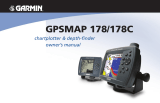
GCV™ 20 INSTALLATION
INSTRUCTIONS
Installation Instructions
Important Safety Information
WARNING
See the Important Safety and Product Information guide in the
product box for product warnings and other important
information.
You are responsible for the safe and prudent operation of your
vessel. Sonar is a tool that enhances your awareness of the
water beneath your boat. It does not relieve you of the
responsibility of observing the water around your boat as you
navigate.
CAUTION
Failure to install and maintain this equipment in accordance with
these instructions could result in damage or injury.
Always wear safety goggles, ear protection, and a dust mask
when drilling, cutting, or sanding.
NOTICE
When drilling or cutting, always check what is on the opposite
side of the surface.
Registering Your Device
Help us better support you by completing our online registration
today. Keep the original sales receipt, or a photocopy, in a safe
place.
1
Go to my.garmin.com/registration.
2
Sign in to your Garmin
®
account.
Tools Needed
• Drill and drill bits
• #2 Phillips screwdriver
• Cable ties (optional)
• Marine sealant (optional)
Mounting Location Considerations
• The sounder must be mounted in a location where it cannot
be submerged.
• The sounder must be mounted in a location with adequate
ventilation where it will not be exposed to extreme
temperatures.
• The sounder should be mounted so that the LEDs are visible.
• The sounder should be mounted so that the power and
network cables can be easily connected.
• The sounder should be mounted so that the transducer cable
can be connected. If required, transducer extension cables
are available through your Garmin dealer.
Installation Preparation
NOTICE
This device must be installed according to these instructions to
get the best possible performance. If you experience difficulty
with the installation, contact Garmin Product Support.
Because every boat is different, you must carefully plan the
GCV 20 sounder installation.
1
Select a mounting location.
2
Mount the sounder.
3
Connect the sounder to the Garmin Marine Network and to
power.
4
Connect the sounder to the transducer.
Mounting the Device
NOTICE
If you are mounting the bracket on fiberglass with screws, it is
recommended to use a countersink bit to drill a clearance
counterbore through only the top gel-coat layer. This will help to
avoid cracking in the gel-coat layer when the screws are
tightened.
Stainless-steel screws may bind when screwed into fiberglass
and overtightened. It is recommended to apply an anti-seize
lubricant on the screws before installing them.
Before you mount the device, you must select a mounting
location and determine the mounting hardware needed for the
surface.
NOTE: Mounting hardware is included with the device, but it
may not be suitable for the mounting surface.
1
Place the device in the mounting location and mark the
location of the pilot holes.
2
Drill the appropriate pilot hole for one corner of the device.
3
Loosely fasten the device to the mounting surface with one
corner and examine the other three pilot-hole marks.
4
Mark new pilot-hole locations if necessary, and remove the
device from the mounting surface.
5
Drill the appropriate pilot holes for the other three marks.
6
Secure the device to the mounting location.
Connecting the Sounder
WARNING
When connecting the power cable, do not remove the in-line
fuse holder. To prevent the possibility of injury or product
damage caused by fire or overheating, the appropriate fuse
must be in place as indicated in the product specifications. In
addition, connecting the power cable without the appropriate
fuse in place voids the product warranty.
NOTICE
Do not force a cable into its port. Forcing the cable can damage
the pins. If the cable is properly aligned, the cable should
connect easily.
Before you connect the sounder to the network, power, and the
transducer, you must mount the sounder (Mounting the Device,
page 1).
1
Route the cables using the appropriate tie wraps, fasteners,
and sealant to secure the cables along the route and through
any bulkheads or the deck.
2
Install the locking rings on the marine network and power
cablesxxx.
3
Connect the bare-wire end of the power cable to a 12 Vdc
power source and to ground.
4
Align the notch on the end of the power cable with the power
port on the device, and press the cable into place.
5
Tighten the locking ring.
6
Select an option:
• If your boat is equipped with a GMS
™
10 network port
expander, connect the network cable to an available port
on the GMS 10.
February 2018
190-02408-02_0A



